How to Grow Echeveria
- April 3, 2024
- 0 comment
Echeveria, a genus of succulent plants in the Crassulaceae family, is favored by gardeners and plant enthusiasts for its rosette-shaped leaves and vibrant colors. These plants, native to semi-desert areas of Central America, Mexico, and South America, have adapted well to indoor and outdoor environments. This article provides a comprehensive guide on how to successfully grow and care for Echeveria.

List on How To Grow Echeveria
- Understanding the Basics of Echeveria Cultivation
- Planting and Potting
- Watering and Feeding
- Sunlight and Temperature
- Maintenance and Propagation
Understanding the Basics of Echeveria Cultivation
Selecting the Right Species
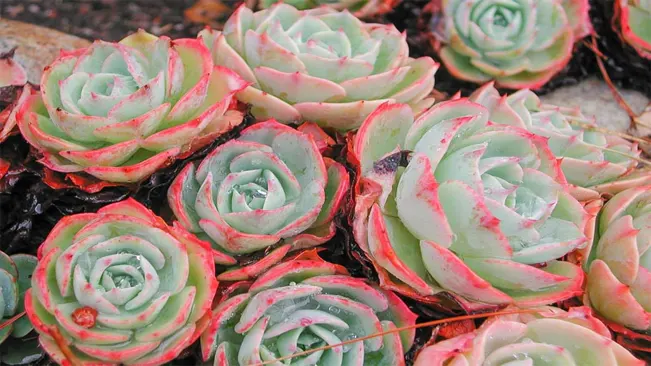
Echeveria Elegans
- Often known as the ‘Mexican Snowball’, this species is popular for its pale green, spoon-shaped leaves which form a symmetrical rosette. It produces pink and yellow bell-shaped flowers in the spring. Echeveria Elegans is particularly hardy and can be a great starter plant for beginners.
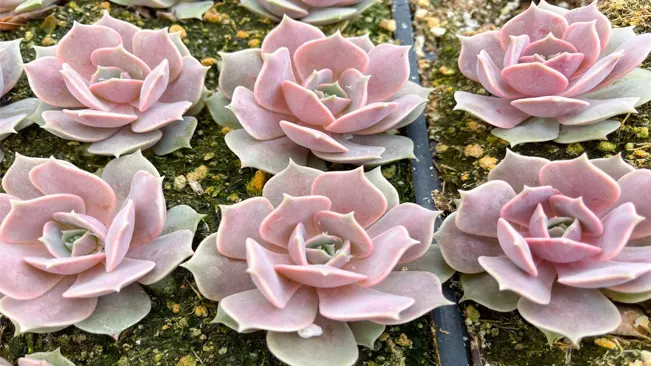
Echeveria Lola
- This variety is known for its lovely pale blue leaves with a hint of pastel pink. The leaves form a tight rosette, creating a sculptural appearance. Echeveria Lola is a bit more delicate than Echeveria Elegans and needs careful attention to prevent sunburn.
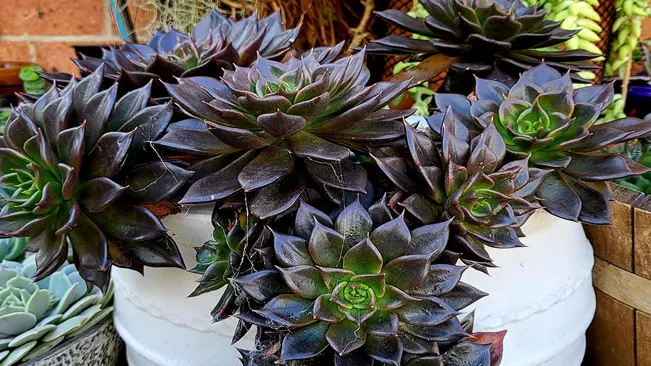
Echeveria ‘Black Prince’
- A striking variety with dark, almost black leaves that form a dense rosette. It produces dark red flowers, which create a beautiful contrast against its dark foliage. The ‘Black Prince’ thrives in full sun and requires a bit more light to maintain its rich coloration.
Climate and Environmental Conditions
- Ideal Conditions: Echeverias naturally grow in semi-desert regions and are adapted to dry, sunny climates. They prefer a temperature range of about 65°F to 70°F (18°C to 21°C) but can tolerate higher temperatures if they’re not exposed to excessive direct sunlight.
- Indoor Cultivation: If you’re living in a region with a colder climate, indoor cultivation is advisable. Place them near a south-facing window where they can receive ample sunlight. Use grow lights if natural light is insufficient.
- Outdoor Growing: In warmer climates, Echeverias can flourish outdoors. They make excellent ground covers or additions to rock gardens. Ensure they are planted in a spot that receives partial shade, especially during the hottest part of the day, to avoid sunburn.
- Temperature Tolerance: Echeverias do not do well in frost. If outdoor temperatures drop below 50°F (10°C), it’s crucial to bring them indoors or provide protection. A greenhouse or a similar structure can offer the necessary warmth and light during winter months.
- Adaptation to Environment: While Echeverias are drought-tolerant, they will require more frequent watering if kept in a humid environment. Conversely, in very dry climates, they might need less watering but will appreciate occasional misting to replicate their natural habitat.
Planting and Potting
Choosing the Right Soil
The choice of soil is a critical factor in the health of Echeveria. These plants need soil that mimics their native, arid environment. The ideal soil should be porous and fast-draining to prevent water retention, which can lead to root rot.
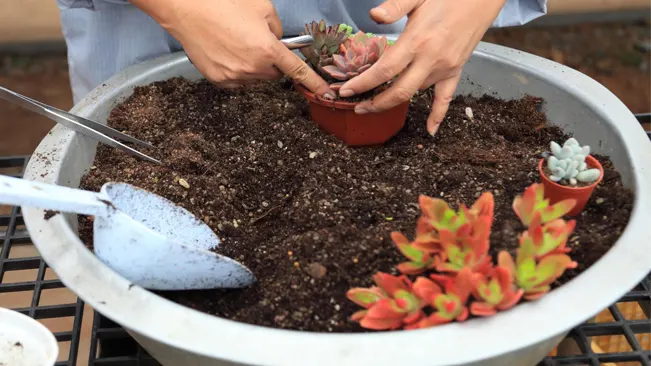
- Cactus or Succulent Mix: These pre-mixed soils are tailored for plants like Echeveria. They usually contain a combination of potting soil, pumice, perlite, and sometimes sand, ensuring good drainage.
- DIY Mix: You can create your own mix by blending regular potting soil with inorganic materials like perlite or coarse sand. A common ratio is 50% potting soil to 50% perlite or sand. This combination enhances drainage and aeration, key for root health.
Pot Selection
The choice of pot is almost as important as the soil. Good drainage is crucial to prevent water from accumulating at the bottom, which can cause root rot.
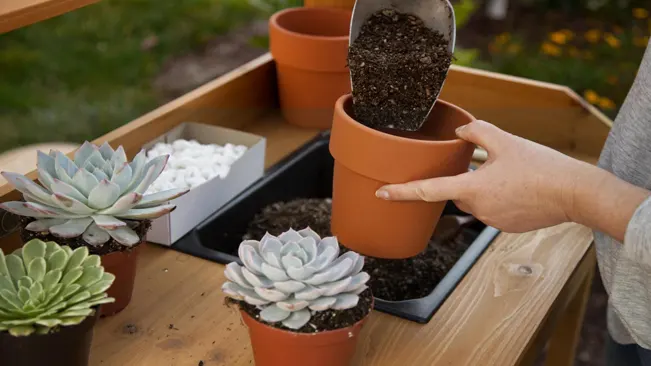
- Drainage Hole: Always choose a pot with a drainage hole. This simple feature is vital for letting excess water escape.
- Terra Cotta Pots: These are highly recommended for Echeveria. Terra cotta is porous, allowing soil to dry more evenly and quickly than in plastic or glazed ceramic pots. It also helps air to reach the roots, which is beneficial for the plant’s health.
- Size of the Pot: The pot should be slightly larger than the plant’s root ball, giving it enough space to grow but not so large that the soil stays wet for too long.
Planting Procedure
Proper planting technique is essential for the health of your Echeveria.
- Dry Soil: Start with dry soil to reduce the risk of root rot. Watering should only be done after the plant has been potted and the roots have had a chance to settle.
- Placement: When placing the Echeveria in its new pot, ensure the lowest leaves are just above the soil surface. Burying the leaves can lead to rot, as they may retain moisture and not dry out properly.
- Aftercare: Once planted, wait a few days before watering to allow the roots to heal and adjust. This minimizes the risk of root rot and gives the plant a better chance of thriving in its new environment.
Watering and Feeding
Watering Schedule
The watering needs of Echeveria are primarily influenced by the season and the plant’s growth cycle.

- Spring and Summer: During these months, Echeveria enters its active growth phase. This is when the plant benefits from more frequent watering. The rule of thumb is to wait until the soil is completely dry before watering again. To check, stick your finger about an inch into the soil; if it’s dry, it’s time to water. When you do water, do so thoroughly, allowing the water to run out of the drainage holes of the pot. This ensures that the roots get enough moisture without becoming waterlogged.
- Fall and Winter: In the cooler months, Echeveria goes into a dormant state. Its water requirements decrease significantly during this period. Watering once a month or even less often is usually sufficient. Overwatering during this dormant phase can be particularly harmful, leading to root rot and other issues.
Fertilizing
Echeverias, like many succulents, are not heavy feeders, but they do benefit from occasional fertilization.
- Type of Fertilizer: Use a succulent-specific or low-nitrogen fertilizer. High nitrogen levels can promote rapid, weak growth that isn’t ideal for succulents. A balanced 20-20-20 fertilizer diluted to half strength is a good choice.
- Frequency: Fertilize only during the growing season, which is typically in the spring and again in the summer. Over-fertilizing, especially during dormancy, can harm the plant.
- Application: Apply the fertilizer according to the instructions, usually diluted in water. It’s best to water the plant normally before applying the fertilizer solution to avoid root burn.
Sunlight and Temperature
Sunlight Requirements
Echeverias are sun-loving plants but they appreciate a balance. Here’s what you need to consider:
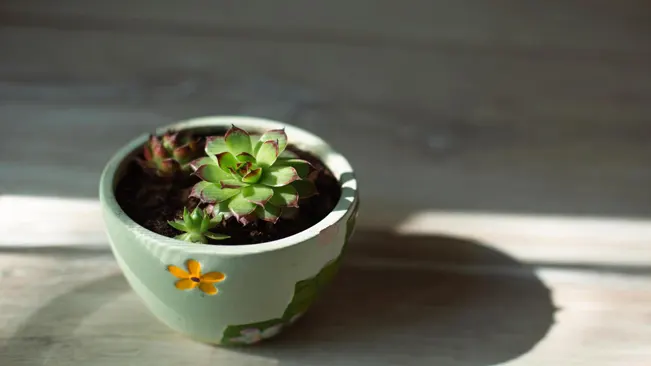
- Ideal Light Conditions: These plants thrive in bright but indirect sunlight. A spot that receives several hours of morning sunlight followed by partial shade in the afternoon is optimal. This mimics their natural habitat where they receive intense light but are often shaded by rocks or other plants.
- Indoor Lighting: If you’re growing Echeveria indoors, place them near a south-facing window to ensure they get enough light. East or west-facing windows can also work. During shorter winter days, supplementing with grow lights may be necessary to prevent etiolation.
- Etiolation: This is a condition where the plant stretches towards the light source, causing the stem to elongate and the leaves to spread apart. It’s a sign that your Echeveria is not receiving enough light. If this happens, gradually increase light exposure; sudden changes can shock the plant.
- Sunburn: On the flip side, too much direct sunlight, especially during the hot midday sun, can scorch the leaves, causing them to turn white or brown. This is more of a concern in hotter climates or during heat waves. In such cases, provide partial shade or use a sheer curtain to diffuse intense sunlight.
Temperature Range
Echeverias, like many succulents, prefer stable, moderate temperatures:
- Optimal Temperature: The sweet spot for these plants is between 65°F and 70°F (18°C to 21°C). This range is typically easy to maintain in most indoor environments and is comfortable for outdoor growth in many climates during spring and fall.
- Winter Care: Echeverias are not frost-hardy. If the temperature dips below 50°F (10°C), it’s crucial to bring outdoor plants inside. Even a brief exposure to frost can damage these succulents. When indoors, keep them away from drafty windows and doors.
- Summer Heat: While they can handle higher temperatures, prolonged exposure to extreme heat can stress the plants. Ensure they have adequate airflow and some protection during the hottest part of the day.
- Temperature Fluctuations: Sudden changes in temperature can stress Echeverias. Try to avoid moving them frequently between very different environments (like from an air-conditioned room to a hot balcony).
Maintenance and Propagation
Pruning

- Removing Dead Leaves: Over time, the lower leaves of an Echeveria may dry out and die. It’s important to gently remove these leaves by carefully pulling them away from the stem. This is not only for cosmetic reasons; dead leaves can attract pests and harbor fungal diseases.
- Shaping the Plant: Occasionally, you might find your Echeveria growing unevenly, especially if it’s not receiving uniform light. You can gently prune it to maintain a balanced shape. However, Echeverias are generally slow growers, so heavy pruning is rarely necessary.
- Preventing Rot: If you notice any signs of rot, especially at the base of the plant or on lower leaves, prune these parts away immediately. Rot can spread quickly and is often a result of overwatering or poor drainage.
Propagation

Leaf Cuttings
- Selection: Choose a healthy, full-grown leaf. Avoid very young or old, shriveled leaves.
- Separation: Gently twist the leaf from the stem. Ensure a clean break, as torn leaves may not propagate successfully.
- Callousing: Allow the leaf to dry and form a callous over the cut area for a few days to a week. This process prevents rot and infection.
- Placement: Lay the leaf on top of well-draining soil. Avoid burying it in the soil. In a few weeks, you should see tiny roots and a new rosette forming at the leaf’s base.
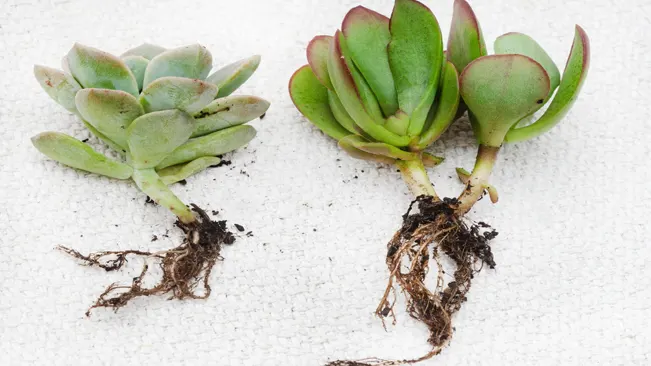
Offsets (Pups)
- Echeverias often produce small offsets around their base. These can be carefully separated from the mother plant when they are a few inches tall.
- Use a clean, sharp knife to detach the offset, ensuring it has some roots attached.
- Allow the offset to callous for a few days before planting it in its own pot.
Seeds
- Propagating Echeveria from seeds is a slower process but can be rewarding.
- Sow the seeds in a well-draining soil mix and keep them moist and warm until germination.
- This method requires patience, as it can take longer for seedlings to develop into mature plants.
Related Growing Guides:
Conclusion
Echeveria is a rewarding plant to grow, offering a range of colors, textures, and shapes. With the right care, these plants can be a stunning addition to your garden or indoor plant collection. Remember, the key to a healthy Echeveria is simulating its natural environment as closely as possible.
FAQs (Frequently Asked Questions)
- What is the ideal soil for Echeveria?
Echeveria requires well-draining soil. A cactus or succulent mix is ideal. You can also make your own mix by combining regular potting soil with sand or perlite. - How often should I water my Echeveria?
Water Echeveria deeply but infrequently, allowing the soil to dry out completely between waterings. During the growing season (spring and summer), you might water every 1-2 weeks, depending on the humidity and temperature. In winter, reduce watering to once a month or less. - Does Echeveria need full sun?
Echeveria prefers bright, indirect sunlight. It can tolerate some direct sunlight, but too much can cause the leaves to scorch. If the plant is indoors, a south or west-facing window is a good spot. - Can Echeveria survive in cold weather?
Echeveria is not frost-tolerant. It should be kept in temperatures above 50°F (10°C). If you live in a cold climate, it’s best to grow Echeveria indoors or in a greenhouse during the winter. - How do I propagate Echeveria?
Echeveria can be propagated from leaf cuttings, offsets (pups that grow at the base of the plant), or seeds. For leaf cuttings, gently twist a leaf from the plant, let it callous over for a few days, then place it on top of soil until it roots. - When is the best time to repot Echeveria?
Repot Echeveria in the spring or early summer, which is the beginning of its active growing season. Choose a pot only slightly larger than the current one as these plants prefer a snug fit. - How do I know if I’m overwatering my Echeveria?
Signs of overwatering include soft, mushy leaves or rot at the base of the plant. If the leaves are discoloring or falling off easily, it may also indicate too much water. - Can Echeveria grow indoors?
Yes, Echeveria can grow indoors if provided with enough light. A south or west-facing window is usually ideal. Consider using grow lights if natural light is insufficient. - Do I need to fertilize my Echeveria?
Echeveria benefits from light fertilization. Use a diluted low-nitrogen succulent fertilizer once in the spring and once in the summer. - How do I deal with pests on Echeveria?
Common pests include mealybugs and aphids. Treat infestations with insecticidal soap or neem oil, and remove any affected leaves or parts of the plant.

Emma Hudson
Forestry AuthorEmma's experience in farming shapes her detailed guides on gardening and farming tools, providing practical, actionable advice grounded in real-world experience. Her work targets both newcomers and experienced farmers, aiming to enhance their practices with a mix of traditional wisdom and modern techniques. By making complex agricultural concepts accessible, Emma's guides serve as valuable tools for those navigating the challenges of contemporary farming, offering strategies for sustainable success.






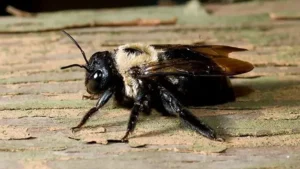




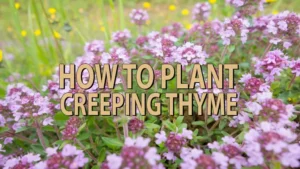
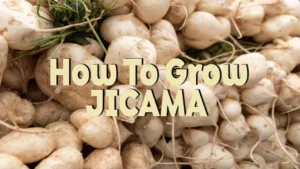
Leave your comment